Large language models (LLMs) have quickly become a buzzword for businesses and artificial intelligence (AI) enthusiasts. LLMs seem to be able to do everything, from detecting financial fraud to planning a dinner menu for six. But can an out-of-the-box solution really do any task for your business?
Adopting an LLM is costly and complex, so you need to know exactly how and why you’re doing it, as well as which LLM fits your requirements and how much additional training it needs. In this article, we explore common types of LLMs, practical large language model use cases in different industries, and key considerations for LLM adoption.
This article will be useful for business leaders and product owners who are looking into adopting an LLM and are searching for practical knowledge about this technology.
Contents:
- Why do businesses adopt LLMs?
- What are the key types of LLMs?
- What are practical use cases for LLMs?
- Key considerations of LLM adoption
- 1. What relevant regulations or laws must you consider?
- 2. Can you use available models?
- 3. How can an LLM influence the security of your sensitive data?
- 4. How can you use an LLM cost-efficiently?
- 5. What will you do with AI bias and hallucinations?
- Conclusion
Why do businesses adopt LLMs?
Large language models are sophisticated AI systems designed to understand and generate texts similarly to humans. These models use deep neural networks and training datasets to learn to understand language, grasp a text’s context, and coherently respond to a user’s prompt.
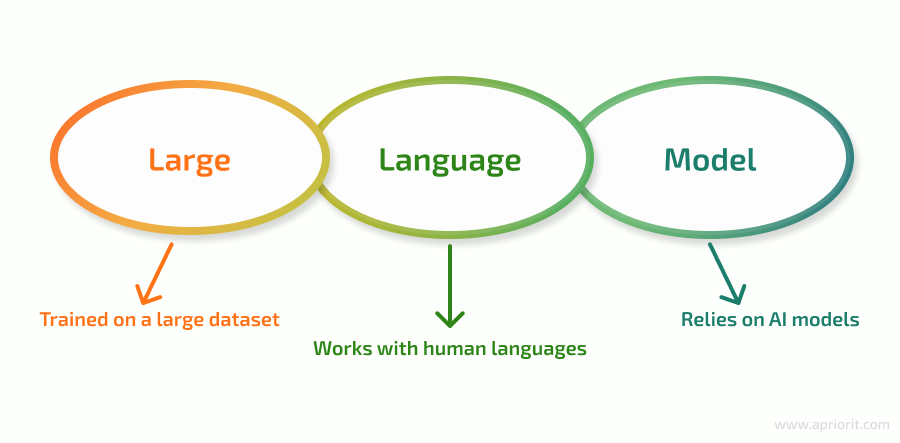
Compared to non-AI text generation software, an LLM provides a more relevant response to a user’s request. It can understand relations between words and sentences, as well as remember the context of a whole conversation with a particular user.
Though LLMs are an emerging technology, they are already in high demand among businesses. LLM-based solutions are part of the generative AI market, which is expected to grow from $11.6 billion in 2023 to $76.8 billion in 2030 according to MarketsAndMarkets.
Each business that integrates LLM into its operations expects their own particular outcome. However, we can group commonly expected benefits into the following categories:
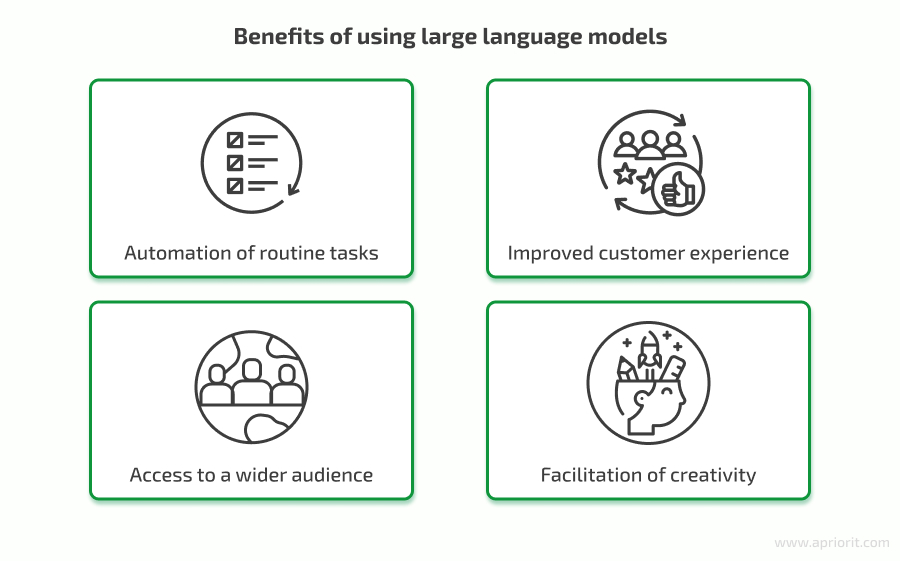
Automation of routine tasks. An LLM can generate basic texts, analyze content, conduct preliminary research, and do other tasks that are usually done by humans. Adopting an LLM-based solution allows employees to use their time for more challenging tasks that require a human touch. However, the results of an LLM’s work still need to be reviewed and verified — we’ll talk about that later.
Improved customer experience. When applied to customer relationships, LLMs can provide personalized, contextualized, and almost instant responses to customer requests. Compared to rule-based customer support solutions, a fine-tuned LLM can solve a customer’s issue faster and more accurately. Also, an LLM can collect information from customers and structure it for a support specialist to review.
Access to a wider audience. A general-purpose LLM can usually communicate with users in numerous languages for an unlimited amount of time, and it adapts its answers to their needs. An LLM can help users engage with a product or service by explaining how it works and helping users resolve issues. An LLM can also make a product or service more accessible by, for example, describing an image.
Facilitation of creativity. While there are some concerns that AI will do all creative work in the future, now it is mostly used to help with creative tasks. For instance, LLMs can generate ideas for marketing campaigns, prepare drafts of social media posts, rewrite texts, and suggest improvements.
To achieve each of these benefits, businesses have to use a particular type of LLM. In the next section, we take a look at key types of large language models and give examples of each.
What are the key types of LLMs?
There are many ways to classify large language models depending on their goals, training, algorithms, etc. One model can belong to several types, and one software product can contain LLMs of different types required by their target audience.
Here are the key and examples of large language models in the market:
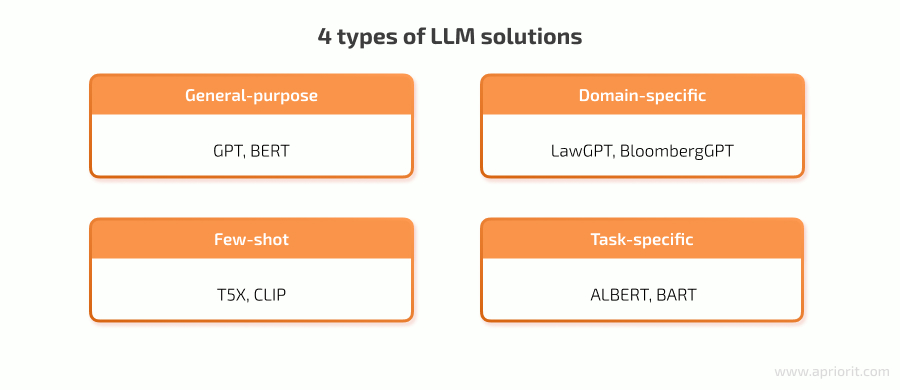
- General-purpose LLMs are versatile models trained to handle various language tasks, from answering questions to conducting research. Such models require diverse datasets, enabling them to understand and generate text for multiple domains and contexts. The most well-known examples of general-purpose LLMs are GPT and BERT.
- Domain-specific LLMs are trained to work within a specific line of work, such as healthcare, law, or software development. Training datasets for such models are focused on a domain’s terminology, patterns, context, etc. Domain-specific LLMs still can respond to general prompts, but they often provide an incoherent response to requests that lie outside their expertise. Examples of such models are Med-PaLM, LawGPT, and BloombergGPT.
- Few-shot LLMs are trained to provide useful responses with a limited amount of relevant labeled data. This type of model focuses on AI’s ability to learn and adapt to new challenges. Few-shot LLMs can be both general and domain-specific. They are used when it’s impossible or unprofitable to collect a dataset. Examples of such LLMs are T5X and CLIP.
- Task-specific LLMs are designed to carry out a particular type of language task: sentiment analysis, translation, question answering, etc. Similarly to domain-specific LLMs, these models use a particular set of training data and can’t provide quality results for tasks outside their expertise. ALBERT and BART are common examples of task-specific LLMs.
Organizations from different industries benefit from different types of LLMs. For example, retail and media companies can use general-purpose models to translate their texts and communicate with a wide audience in real time. Healthcare, financial, and software development organizations can use domain-specific and task-specific LLMs to carry out highly professional activities. Educational facilities can provide virtual tutoring to their students using few-shot LLMs.
In the next section, we analyze practical LLM use cases across industries.
Looking into developing an LLM-based product?
Benefit from Apriorit’s expertise in working with AI!
What are practical use cases for LLMs?
LLMs have a broad range of practical applications across various business domains. Generally speaking, you can apply an LLM to any task that requires text generation or text-based communication, as long as it’s trained to perform such tasks.
Most businesses value the following use cases for large language models:
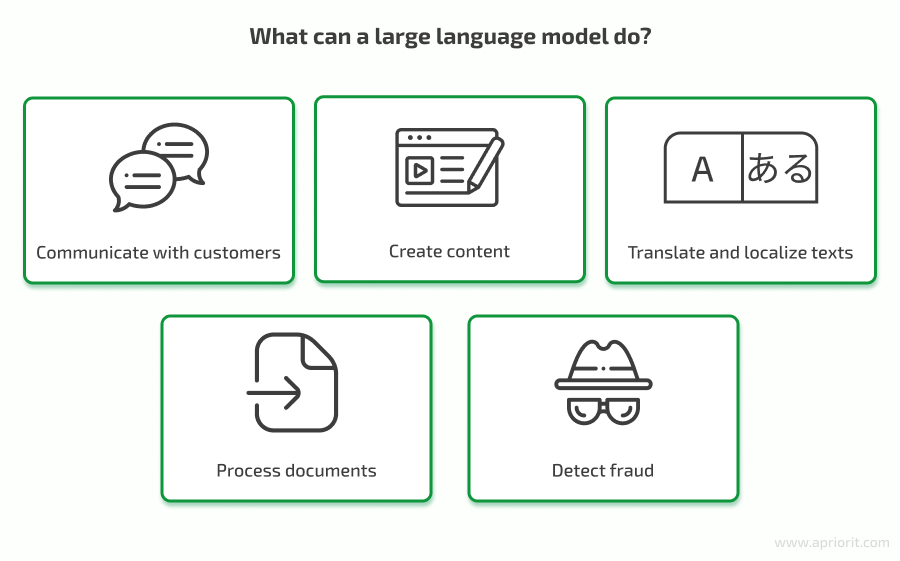
Communicate with customers
Understanding text and communicating in a human-like manner is one of the core and most common applications of an LLM. Large language models are widely applied in chatbots and customer support systems, where an LLM helps customers resolve their issues without the help of human specialists. In this scenario, an LLM has to be trained on a custom database: say, documentation or the user manual for a product. It treats a user’s request as a prompt and provides an answer based on its training and the context of the user’s input.
Lots of industries have already adopted communicative LLMs in their routines. Here’s how organizations in the following industries can use AI-based chatbots:
- Retail — consult customers, provide 24/7 customer support, collect feedback on product or service quality
- Education — implement smart virtual tutors to assist students and facilitate their learning process
- Healthcare — consult patients on simple medical issues, collect medical history and symptoms, provide personalized assistance
- HR — help employees during onboarding, conduct surveys and collect feedback, train employees on corporate policies
Create content
Though the ability of AI to generate truly unique and creative texts is debated, AI models can certainly help businesses improve their content creation processes. When used to enhance the creative process rather than replace it, an LLM can automate a lot of routine activities, conduct initial research, and provide starting ideas for writing texts.
For example, businesses can use generative LLMs for:
- Marketing — draft blog articles and social media posts, create product descriptions, generate topics for marketing content, review texts
- Media — research ideas for creative texts, provide drafts for scenarios, write simple journalistic articles
- Software development — generate code, create user manuals and documentation based on available code
Note that after the successful strike of the Writers Guild of America, many industries have been discussing the impact of large language models and debating regulations on the use of generative AI in their line of work.
Translate and localize texts
A lot of general-purpose LLMs can communicate with users in numerous languages at the same time with the same quality of replies and contextual understanding. For example, ChatGPT knows over 95 languages. It’s challenging for any organization to gather a team of translators with such knowledge. On top of that, an LLM can understand cultural context and adapt texts to it by, for instance, finding corresponding idioms and metaphors.
Such capabilities of LLMs are especially useful for:
- Media — reach international audiences with translated texts, add cultural context to content, avoid publishing offensive content
- Gaming — help localization teams translate in-game texts, provide support to players, translate messages in online chats
- Education — adapt educational materials, engage with students from all over the world
- Retail — provide support to a wider range of customers, translate help documents, generate new product and service descriptions
Read also
Starting a New AI Project: 12 Questions to Assess If You’re Ready
Get properly prepared to deliver a sustainable, cost-efficient, and competitive product!

Process documents
Harnessing the ability of large language models for AI text analysis can simplify work with documentation. LLMs can parse, summarize, categorize, rewrite, improve, and answer questions about documents. These abilities allow for LLM integration into corporate software like contract management or human resources management systems to automate part of employees’ work.
LLMs also help organizations comply with laws, acts, and regulations. An LLM can parse large documents with requirements in seconds, describe how to achieve compliance, and consult employees responsible for implementing applicable requirements.
Here are practical examples of using LLMs for document processing:
- Legal — analyze legal documents, identify weak clauses, consult clients on simple legal issues
- Education — conduct research, summarize scientific studies, prepare questions and test students’ knowledge
- Software development — organize text databases, prepare documentation based on a product’s code
Detect fraud
From a data analysis standpoint, fraud is a data anomaly — data that differs from other data and from expectations. AI is often used to detect data anomalies because it can analyze massive data volumes, learn and self-improve based on the data it has, and detect hidden and sophisticated threats.
A large language model can detect potentially false and fraudulent statements in texts. While the results of such detection should still be reviewed by a specialist, using an LLM for this task speeds up and improves the quality of fraud detection.
In practice, an LMM can detect fraud in various fields:
- Law — detect unusual clauses, highlight documents and statements that break the law, assess clients’ requests and statements
- Finance — detect insider trading and money laundering, prevent abuse of banking systems, identify suspicious financial transactions
- Insurance — check insurance claims for fraud, assist clients with claims
- Social networks — identify messages with scams, threats, and hate speech; combat fake news and impersonation; block bots
Note that an LLM can efficiently perform any of these tasks only if it was developed and trained to do so. Whether you decide to go with an out-of-the-box solution or build a custom AI system, there are also several crucial factors you should consider before enhancing your product with LLM capabilities.
Read also
AI in Auto Insurance: Possibilities, Challenges, Implementation Tips
Explore how AI can revolutionize auto insurance and how you can prepare for its adoption.

Key considerations of LLM adoption
Despite the huge number of out-of-the-box large language models available on the market, using them as-is isn’t always beneficial for a particular business. Without adjustments like custom training and additional data protection, such solutions can leak data and return hallucinations — answers that seem right but are in fact made up.
Before starting the LLM adoption process, answer the following questions:
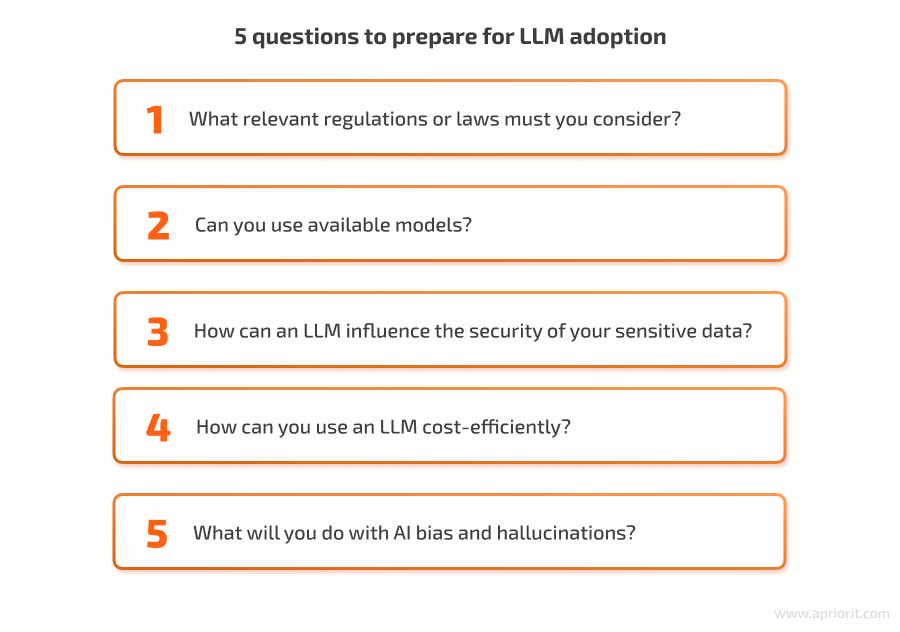
1. What relevant regulations or laws must you consider?
As AI-based solutions become common in many industries, governments all over the world have started passing laws and adopting regulations to control them. For example, the European Union is working on the AI Act, which will contain safeguards for various types of AI, including generative. The US is working on its AI Bill of Rights, and many other countries have similar initiatives.
On top of national laws and regulations, many industries also have rules on using AI. The World Health Organization has released regulatory considerations on implementing AI in healthcare. The US Consumer Financial Protection Bureau provides guidance for financial organizations that use AI for credit rulings. Such recommendations and regulations usually touch upon both the technical and ethical sides of using AI tools.
The current situation with AI legislation is chaotic, but it’s still worth studying current and proposed laws and regulations that may be relevant to your business. Then, you can decide how to use an LLM to stay compliant and improve your processes.
Besides AI-related regulations, you also need to find a way to adhere to existing cybersecurity requirements like the GDPR, PCI DSS, and ISO 27001. Most AI solutions process sensitive data and therefore have to comply with these and other laws, standards, and regulations.
To help our clients stay ahead in a shifting regulatory landscape, Apriorit’s business analysts conduct deep market and industry research to crystalize use cases and final requirements for our clients’ solutions. Only after this do we start designing a product.
2. Can you use available models?
Adapting an existing large language model to your needs is much faster, cheaper, and (in some cases) more efficient than developing a robust large language model from scratch. When you understand your requirements and legal considerations for using an LLM, you can decide whether an existing model will fit your needs.
Here are some open-source models you can use as the basis of your solution:
- Bidirectional Encoder Representations from Transformers (BERT) — a language model developed by Google researchers that is trained to perform a variety of natural language processing (NLP) tasks.
- LaMDA-pytorch — an open-source implementation of another LLM from Google trained to maintain a human-like conversation on a variety of topics without losing the context of the dialog.
- Llama 2 — Meta’s large language model that is pre-trained and fine-tuned to chat with users and generate code using popular programming languages.
- NVIDIA NeMo — an open-source version of NVIDIA’s Megatron model that provides a conversational AI toolkit for various NLP tasks.
- BLOOM — a model developed by BigScience to generate text and code based on small prompts, summarize texts, and answer questions about them.
When choosing an open-source foundation for our projects, we consider a model’s capabilities, customizability, community support, known cybersecurity issues, and other parameters.
Note that you’ll probably need to fine-tune an existing model to make it fit your particular needs. Using an LLM that’s pre-trained on general texts isn’t efficient for narrow topics like discussing industry-specific issues or particular products. Fine-tuning usually requires creating a custom high-quality dataset and conducting additional training — two more tasks Apriorit can help you with.
Read also
Can You Rely on GPT in AI Development Projects?
Examine the pros and cons of using GPT for software development based on our practical examples.

3. How can an LLM influence the security of your sensitive data?
While LLMs themselves are not inherently malicious, malicious actors can abuse them to get access to your training data, internal code, and other sensitive information. You can start exploring security-related risks of adopting an LLM with OWASP’s top 10 vulnerabilities for LLM applications to secure your solution from the following common vulnerabilities:
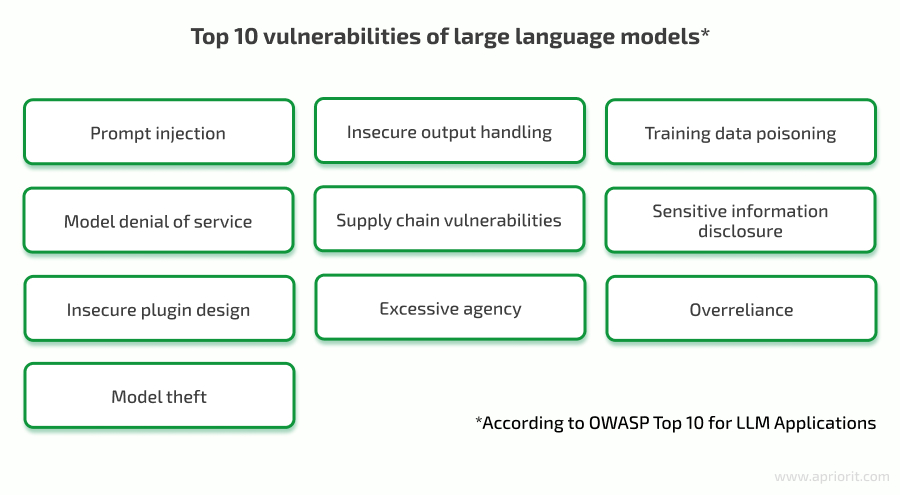
This list describes the most common vulnerabilities of LLM-based solutions, ways they can be abused, and possible outcomes of such incidents. It’s best to assess these risks and create a mitigation plan before you start adopting a large language model. This way, you’ll be able to build in protection mechanisms and know how to handle an incident.
As a cybersecurity-oriented development company with over 20 years of experience, we design all of our solutions with security in mind. We start ensuring AI security by creating an anonymized dataset that contains only the records needed to train our solution. During development, we minimize our team members’ access to sensitive records and trade secrets clients share with us, as well as encrypt data we use.
Read also
LLM Prompt Injection Protection for AI Chatbots
Explore how a prompt injection attack works and what you can do to protect your chatbot from it.

4. How can you use an LLM cost-efficiently?
Whether you decide to build a custom LLM or fine-tune an existing model, it’ll still need a ton of computing resources to process your requests. You’ll need to either find a way to procure expensive and powerful hardware or overspend on cloud services.
High resource consumption is a feature of any AI-based technology that you can’t change, at least for now. What you can do is structure your LLM usage in such a way that the cost is manageable for your business. For example, you can:
- Review LLM use cases to employ an LLM only for tasks that absolutely need AI
- Choose an open-source model or a cloud service with affordable rates
- Host your solution using pay-as-you-go cloud services
- Cache results for the most common prompts
- Process user requests in batches
- Implement rate limiting for excessive LLM usage
To control the cost of developing and deploying our LLMs, Apriorit specialists start by accurately estimating the budget and agreeing on it with the client. We can reduce the cost of development by using free open-source tools and pre-trained algorithms. We also monitor resource use to detect anomalies in a timely manner.
5. What will you do with AI bias and hallucinations?
The possibility of biased and wrong answers is one of the key risks of using a large language model. When a user asks an LLM something it doesn’t know, the model can behave like a school student: try to guess the answer instead of admitting that it doesn’t know how to respond. Such responses can damage a business’s reputation, scare off or discriminate against potential clients, and lead to harmful decisions.
One way to avoid wrong answers is by investing in LLM testing:
- Quality assurance to check that the model works as intended and corresponds to the initial product requirements
- Bias testing to check if the model provides biased responses and assess how AI bias influences the model’s accuracy
Apriorit’s quality assurance team thoroughly tests all solutions we build before their release. They can also audit an existing product to provide an unbiased assessment of its quality and security posture, as well as provide improvement tips.
Conclusion
An LLM is a diverse and potent type of AI solution that can revolutionize many text-related tasks, from customer communication to content generation. While the AI market is bustling with a variety of large language models, businesses have to do a lot of homework before adopting such solutions.
To benefit from an LLM and manage the risks it imposes, consider clearly outlining use cases for your model and the expected outcomes of its adoption. Also, assess existing solutions, the efforts required to adjust them to your tasks, and the cost of implementation and usage.
Apriorit’s AI development team has hands-on experience using open-source LLMs for various tasks and developing custom large language models for our clients. We can help you figure out the most efficient way to enhance your product with an LLM and manage risks associated with the use of this technology.
Looking for a reliable LLM development partner?
Reach out to see how Apriorit experts can help you deliver a competitive and efficient AI product!


